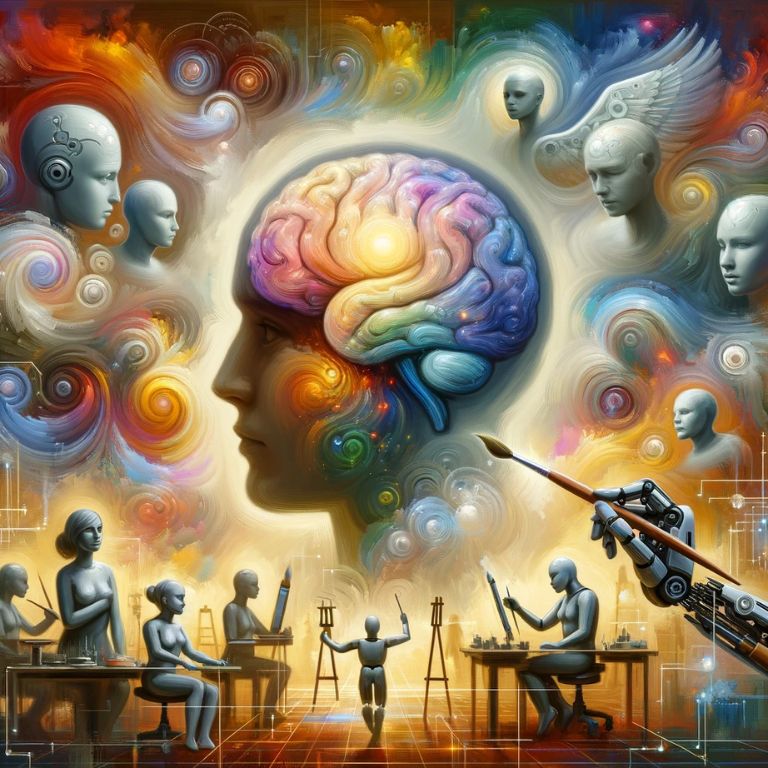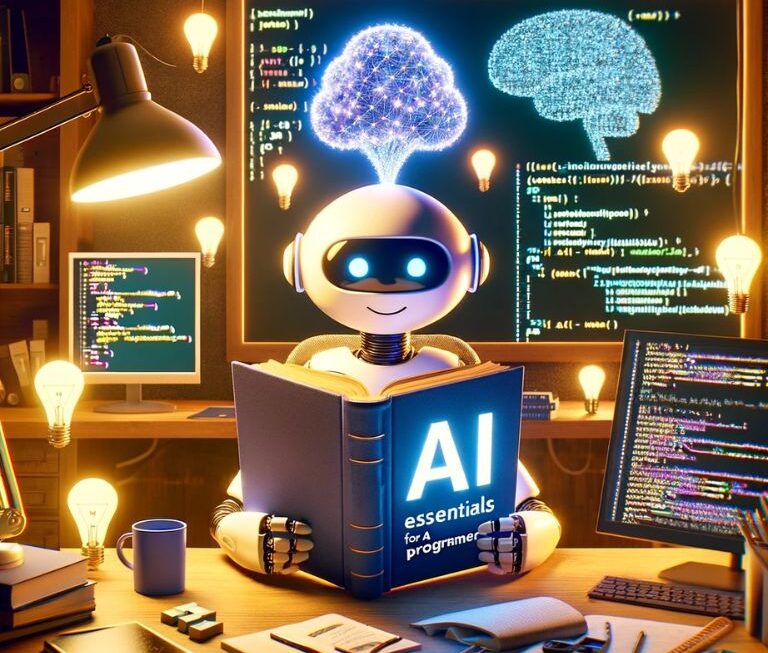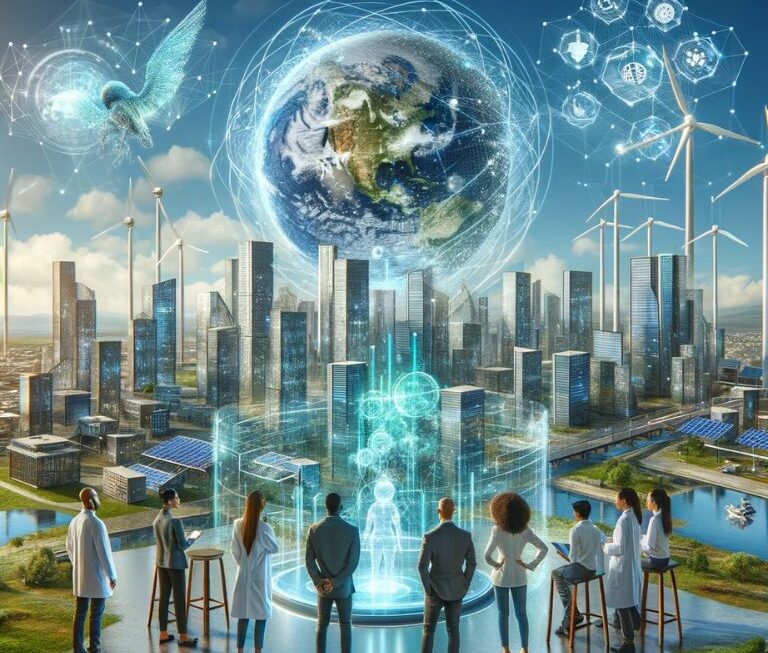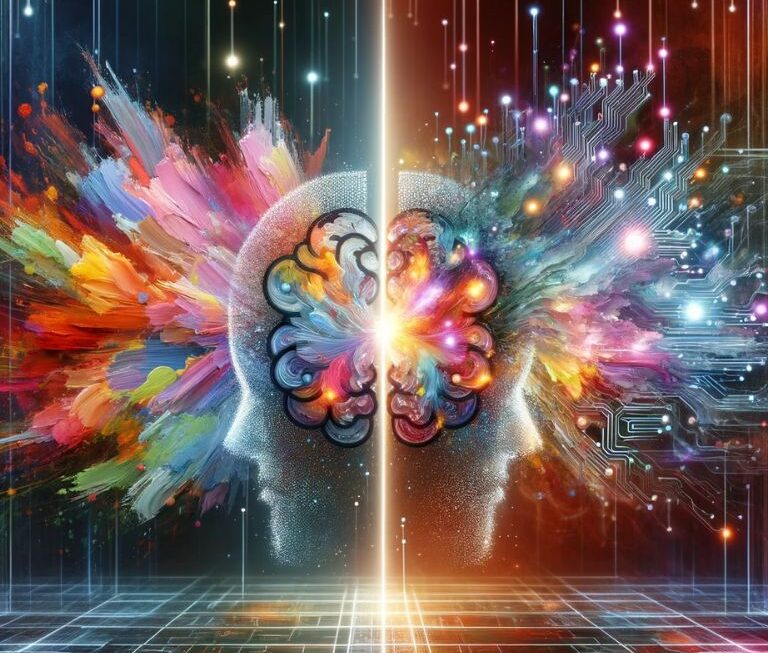AI-generated art represents a transformative fusion of artificial intelligence and creative expression. It encompasses a wide array of visual and auditory forms, from paintings and sculptures to music and literature, produced through algorithms and machine learning. This burgeoning field challenges traditional definitions of art, pushing the boundaries of human creativity, and offers novel perspectives on the interplay between technology and artistic innovation.
Overview of AI in Art Creation
AI has revolutionized art by using algorithms and machine learning to create paintings, drawings, digital art, and sculptures. It learns from vast datasets, including existing artworks, to produce pieces either with human guidance or autonomously. AI art’s appeal lies in its capacity to merge styles and techniques, yielding unconventional and boundary-pushing creations. Whether reinterpreting classical art with a modern twist or crafting abstract forms, AI art showcases technology’s limitless creative potential.
Rise of AI as a Tool in the Art World
AI’s rise in the art world is reshaping creation and perception. Galleries and online platforms now feature AI-generated art, sparking acceptance and discussions. AI is both creator and collaborator, assisting artists in realizing intricate visions. It democratizes art, enabling everyone to explore and diversify creativity. This evolution challenges authorship and originality concepts, shaping a future where technology and human creativity coexist, pushing artistic boundaries.
Defining Authorship in AI Art
The definition of authorship in AI art is a complex debate, as AI systems produce unique works guided by human creators, blurring traditional boundaries.
Who is the Creator: AI or Human?
The debate over authorship in AI-generated art raises complex questions about creativity. AI systems create distinct works but are guided by human artists who define parameters. This blurs traditional artistic boundaries, making it challenging to distinguish human input from AI creativity. The ambiguity reflects art’s evolving nature in the digital age, questioning AI’s role and recognition in the creative process.
Legal Perspectives on AI-Generated Artworks
The legal world is still grappling with how to handle AI-generated art, leading to a range of perspectives and proposed approaches:
- Intellectual Property Rights: AI-generated art challenges existing copyright laws, raising questions about ownership and public domain status.
- Ownership and Liability: Determining ownership and addressing liability issues for AI-created art can be intricate.
- Artist Recognition and Royalties: Traditional artist recognition and royalty models may not fit AI art, requiring legal adaptations for fair compensation.
- International Variations: Diverse legal perspectives on AI art create challenges in the global art market.
- Potential New Legislation: Increasing AI art usage may drive the need for legislation addressing its complexities while protecting creative rights.
Originality and AI: A Complex Debate
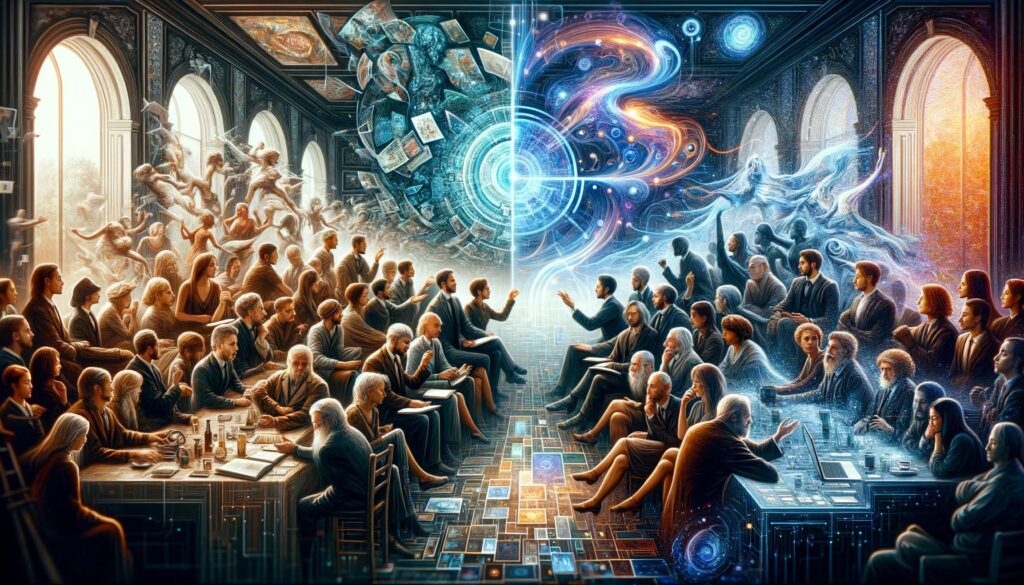
The debate on AI-generated art’s originality delves into the blurred lines of creativity, as AI’s distinct works are shaped by human guidance, challenging traditional notions.
Understanding Originality in the Context of AI
Originality in art is traditionally viewed as the creation of something new and unique, reflecting the personal vision and creativity of the artist. However, in the context of AI, this concept becomes more nuanced. AI algorithms, by their nature, are programmed to learn from existing data, which includes a vast array of art styles and historical artworks. This raises the question: can AI-generated art truly be original, or is it merely a reflection and recombination of what has already been created by humans? The challenge lies in deciphering whether AI can possess the ability to be truly innovative, or if its capabilities are confined to the limits of its programming and the data it has been fed.
AI’s Role in Replicating or Generating Unique Works
AI’s role in art creation oscillates between replicating existing styles and generating works that are ostensibly unique. On one hand, AI can mimic the styles of renowned artists or replicate traditional art forms with astonishing accuracy. This ability not only serves as a tool for artistic exploration but also raises ethical questions about authenticity and the value of replication. On the other hand, AI has shown potential in generating works that are distinct and seemingly original. These creations often result from the AI’s capacity to process and recombine artistic elements in ways that might not naturally occur to human artists. However, even these ‘unique’ works are a product of pre-existing data and algorithms, leading to ongoing debates about the true nature of originality and innovation when it comes to AI-generated art.
Ethical Implications in the Artistic Process
Ethical implications in the artistic process arise from the evolving relationship between AI and human creativity, challenging traditional norms and prompting critical ethical considerations.
The Ethics of Using AI to Mimic Styles of Existing Artists
The use of AI to mimic the styles of existing artists raises several ethical concerns that merit careful consideration:
- Artistic Integrity: There’s an ongoing debate about whether using AI to replicate the styles of established artists compromises the integrity of the original artist’s work. Does it pay homage to their style, or does it diminish their unique contribution to the art world?
- Consent and Rights: The question of consent arises when AI is used to imitate the style of living artists or those whose works are still under copyright. Should artists or their estates have a say in how AI uses their styles?
- Dilution of Value: When AI replicates a famous style, it could potentially dilute the value of the original artist’s works, impacting both their market value and their cultural significance.
- Ethical Use of Data: The ethical use of data in training AI systems is crucial. This includes considerations about the sources of the artwork data used and the rights associated with those works.
- Originality and Creativity: This practice also raises questions about the nature of originality and creativity. Is an AI-generated work in the style of Van Gogh, for example, a new creative expression, or merely a sophisticated form of copying?
Balancing Innovation with Respect for Traditional Artistry
Balancing AI’s innovative capabilities in art while respecting traditional artistry is delicate. AI offers new creative avenues but must honor human artists’ unique qualities, such as personal experiences and emotions. This balance involves embracing AI as a tool to enhance, not replace, human creativity. The goal is an art world valuing technological innovation alongside irreplaceable human expression, fostering harmony between the two.
The Impact of AI on the Art Market
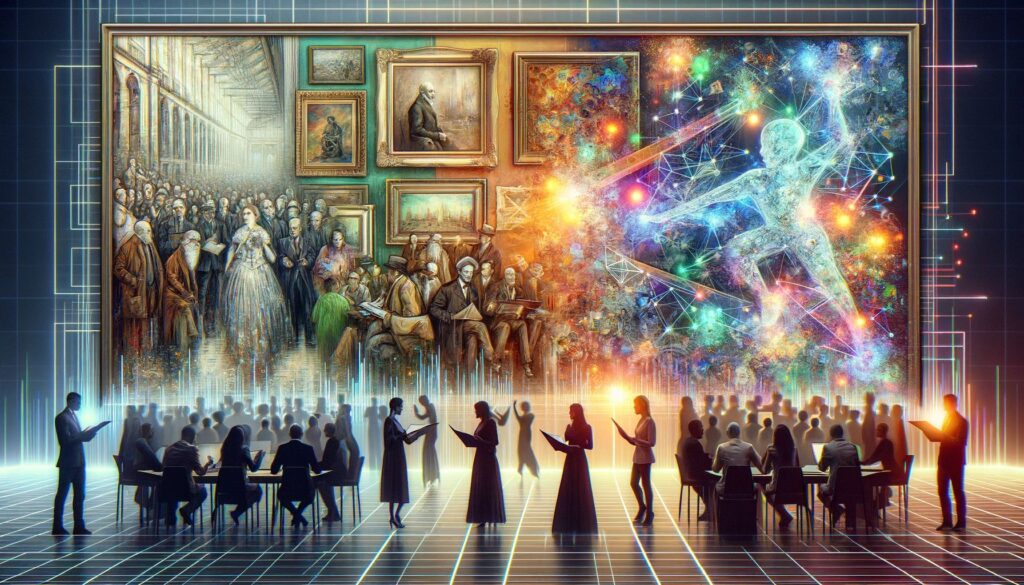
AI is reshaping the art market, introducing AI-generated artworks and altering traditional valuation methods, challenging the industry to adapt to new trends and technologies.
AI Art in Galleries and Auctions
AI-generated art is increasingly gaining recognition in prestigious art galleries and auctions, signaling a shift in the art market’s acceptance of technological innovation. Galleries are showcasing AI artworks, highlighting their unique blend of technology and creativity, and often sparking intrigue and debate among art enthusiasts. Similarly, auctions have seen AI artworks fetching significant prices, with some pieces selling for amounts comparable to those of traditional art. This growing presence of AI art in galleries and auctions not only legitimizes it as a form of artistic expression but also challenges the traditional perceptions of value and artistry in the art world.
Economic Implications for Artists and the Art Market
The rise of AI in art creation and its entry into mainstream art markets bring with it a host of economic implications:
- Market Competition: AI art introduces a new form of competition for human artists, potentially affecting the market dynamics and the way art is valued and sold.
- New Revenue Streams: For artists who embrace AI, it can open up new revenue streams. Collaborations between human artists and AI can lead to unique artworks that might attract different segments of art buyers.
- Accessibility and Diversity: AI democratizes art creation, allowing more people to create and sell art. This could lead to a more diverse art market with a wider range of styles and perspectives.
- Changing Skill Sets: The rise of AI in art may require artists to acquire new skills, such as programming and data analytics, to remain relevant and competitive in the evolving market.
- Intellectual Property Concerns: The economic implications also extend to intellectual property rights. The question of who holds the copyright on AI-generated art – the programmer, the artist who commissioned the work, or the AI itself – can impact revenue and ownership models.
- Investment and Valuation: As AI art becomes more prevalent, investors and collectors may need to develop new criteria for valuing and investing in these works, considering factors like the technology used, the data input, and the creative process involved.
Navigating the Ethical Landscape: Recommendations and Guidelines
Navigating AI ethics requires clear recommendations and guidelines, fostering responsible AI integration while preserving human creativity and values in art.
Establishing Ethical Guidelines for AI-Generated Art
As the field of AI-generated art grows, establishing ethical guidelines becomes essential to navigate this new terrain responsibly:
- Transparency: Clear disclosure about the use of AI in the creation process should be a standard practice, ensuring that viewers and buyers are aware of the nature of the artwork.
- Attribution and Credit: Guidelines need to clearly define how to attribute credit for AI-generated art, balancing recognition between the AI system, its developers, and any collaborating human artists.
- Data Ethics: Ethical considerations regarding the data used to train AI systems, including respecting copyright and privacy laws, are crucial.
- Fair Compensation: As AI impacts the art market, guidelines should ensure fair compensation for all parties involved, including artists, AI developers, and others who contribute to the creative process.
- Cultural Sensitivity: AI art should be created and presented with an awareness of cultural sensitivities, avoiding appropriation and ensuring respectful representation.
- Regulatory Compliance: Adherence to existing laws and regulations regarding intellectual property, copyright, and digital rights is essential.
- Innovation vs. Preservation: Balancing innovation with the preservation of traditional art forms and practices should be considered in developing ethical guidelines.
The Role of Artists, Technologists, and Policymakers in Shaping the Future
The future of AI in art will be significantly shaped by the collaborative efforts of various stakeholders:
- Artists: Artists should be proactive in understanding AI technologies and engaging in discussions about the ethical implications of their use in the art world.
- Technologists: Developers of AI should work closely with artists and ethical experts to create technologies that are responsible and considerate of the artistic process and its impact.
- Art Institutions: Galleries, museums, and educational institutions play a role in fostering dialogues about AI art, curating exhibitions responsibly, and educating the public about this new form of art.
- Policymakers: Governments and regulatory bodies need to develop and enforce policies that address the unique challenges posed by AI in art, ensuring a balanced and fair landscape for all involved.
- Ethicists and Legal Experts: Their involvement is crucial in shaping the guidelines and policies that govern AI art, ensuring that they are ethically sound and legally compliant.
- Art Collectors and Investors: They can influence the market and ethical landscape by making informed decisions and supporting practices that adhere to established guidelines.
Conclusion
The convergence of AI and art is a profound and enduring shift in the creative landscape. AI-generated art challenges conventions of creativity and authorship, igniting debates and unveiling new possibilities. This transformation requires a delicate balance, preserving the human essence in art while embracing innovation. It mirrors human ingenuity and our quest for expressive frontiers. The future promises a fusion of human creativity and AI, redefining artistic boundaries. Collaboration among artists, technologists, institutions, and policymakers, guided by ethics and open dialogue, is essential. This evolution extends beyond art itself, shaping how we weave emerging technologies into our cultural fabric.

